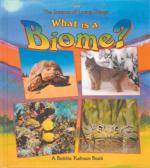|
This section contains 3,221 words (approx. 11 pages at 300 words per page) |

|
An ecosystem is a community of organisms that interact with each other and with the abiotic (chemical and physical) factors in their particular environment. A biome is the largest well-defined ecosystem. Biomes include vast grasslands, continent-wide deserts, and sweeps of arctic tundra. Biomes also include such well-defined ecosystems as coral reefs, lakes, and river systems.
Biomes are characterized by climate, by typical vegetation, and by the way organisms have adapted to that environment. Biomes are not permanent. Grasslands can be transformed into deserts; forests can be converted into grasslands. Climate change at the end of the last Ice Age dramatically altered the biomes of North America because of natural changes in climate and the movements of land masses. Since the Industrial Revolution, human activity has become an increasingly important factor in alteration of biomes.
Biomes are usually classified on the basis of average temperature and precipitation. This classification...
|
This section contains 3,221 words (approx. 11 pages at 300 words per page) |

|


